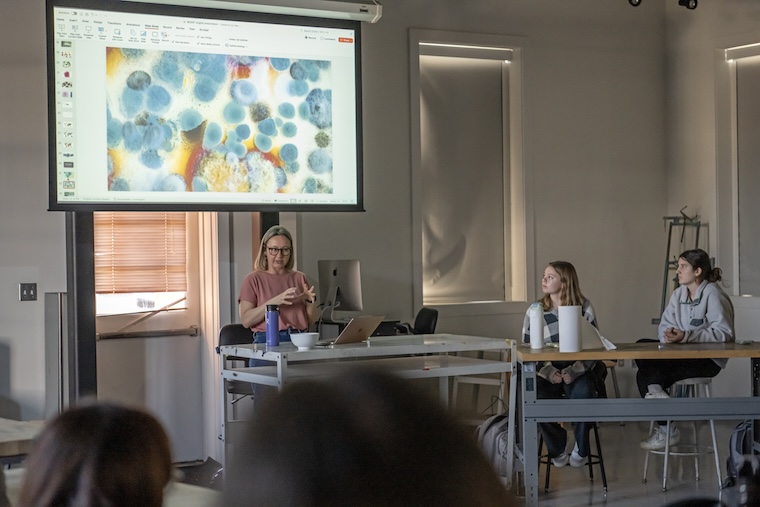Visiting professor shares process and philosophy of her ‘bio-art’
Selin Balci combines her education in science with her artistic practice, using biological mediums to create her works. She gave the first of three visiting faculty artist talks this semester.

Visiting art professor Selin Balci gestures while speaking to a group of students and sharing slides of her art.
When many of us walk through nature we marvel at the leaves or the birds, paying less attention to the fungi. In our homes, we actively fight moisture to prevent the growth of mold spores. For artist Selin Balci, fungi, mold spores, and bacteria are her medium.
Balci gave an artist talk at Washington College Wednesday afternoon, Feb. 14. She is a visiting professor for Art + Art History Department at Washington College this semester, teaching Introductory Photography.
Balci's art combines her education in science with her artistic practice, using biological mediums—including living spores—to create “bio-art.” Bio-art requires an artist to work with biological materials, live tissue, bacteria, living organisms, or the life process and should have a living organism or biological process as part of the work, she explained. The term bio-art was coined by artist Edoardo Kac in 1997.
“Use whatever is out there,” Balci told those in attendance, most of them students. She encouraged folks to combine their interests to make the work more interesting.
As part of her process, Balci collects natural samples—leaves, bark, human hair, and more—and isolates the spores from which she grows her mold and fungi. Providing her spores with a potato base on which to grow, she experiments with color, the way her materials interact with one another, and the growth of her spores over time. In her exhibited works, she grows her spores directly on paper, canvas, panels, or petri dishes in the display. She arranges the component pieces of the installation to show a “human hand” in design with colors or elements woven between separate panels.
Balci described her art as “collaborative” with the spores. Because of that collaboration process, it often takes her several months to complete any given work. While she experiments with spore interactions in petri dishes before putting them on a paper or panel for display, there is an element of surprise to how the final works will turn out. Because she works in a studio, rather than a lab, there is an element of contamination to her work, which happens accidentally as she interacts with her materials.
“I tried to eliminate the contamination, but I noticed I can't ... so I said, ‘You know what? I'm going to be working with it," Balci said. “I started to call all my installations with the name Contamination.”
When she first started creating bio-art, Balci said she did not preserve her works—the spores would continue to grow until they died, and the paper or panel the work was created on would be destroyed. Now, Balci kills the spores and covers her works with epoxy resin, preserving the colors and growth at a particular stage for display.
One event attendee asked Balci if the switch from allowing the work to completely decay to preserving it at a certain stage changed how she thought about the work. Balci said that she has approached her art differently over time and may change her strategy again in the future.
Recently, Balci has experimented with taking polaroid photos and collecting a sample from the subject—a landscape like a beach or a person in the portrait—and letting it grow on the photo itself. Rather than preserve these in resin, Balci takes time-lapse videos of the spores growing, then plays them again in reverse to make it seem like the spores disappear.
Balci said she prefers to have physical copies of her art because she finds the displays are more compelling to the viewer, but videos make it possible to see the process over time.
Balci's talk was the first in a series of visiting studio art faculty artist talks. Interdisciplinary artists Kathie Halfin and Wendy Tribulski will each give a talk later this semester. Halfin — who is teaching Sustainable Art Making this semester — will talk about her own artistic process Thursday, March 28 at 4 p.m. Tribulski — teaching the Visual Messaging through Color and Design course — will speak Tuesday, April 9 at 3:30 p.m. All artist talks are held in Larrabee Studio Arts Center.
— MacKenzie Brady '21